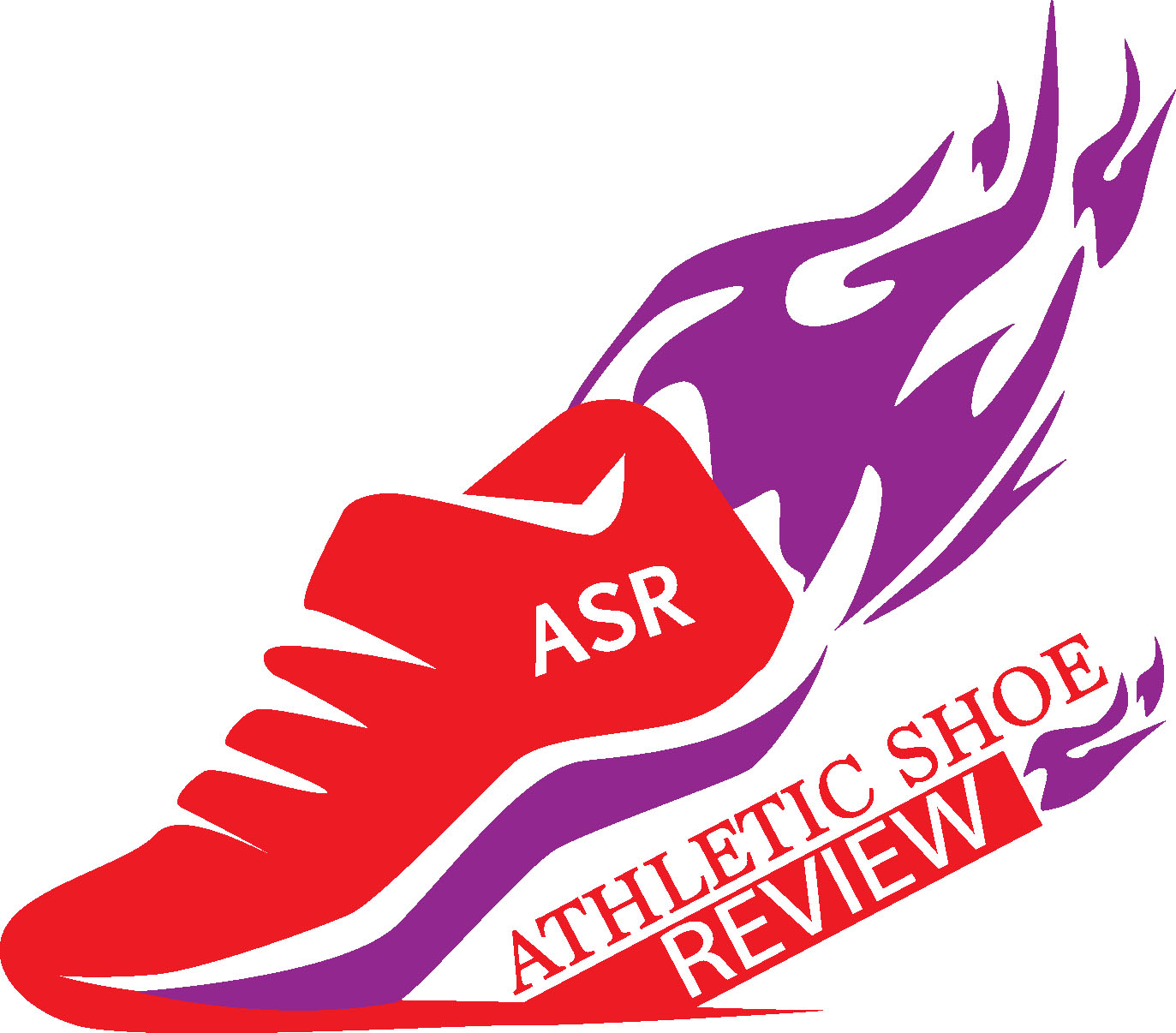

10 Important Athletic Shoe Parts That You Probably Don't Know About,
But Should
If you wear athletic shoes for any reason – running, walking, or just to be comfortable in your daily activities – you probably know about the basic athletic shoe parts. Even if you didn’t know the proper terms, you’re most likely familiar with these features:
Outsole – the bottom of the shoe that gives you traction
Midsole – the part made up of soft, cushioning materials such as air, gel, or foam
Insole – the part inside beneath your feet
Upper – the whole body of the shoe that holds your feet from heel to toe
Laces – the round or flat “ties” that tighten and hold your feet in your shoes
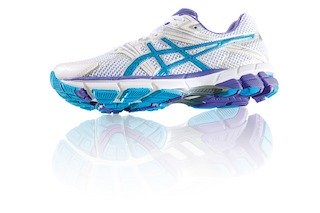
(You can check out this webpage for more information about the above features.)
But there are a lot more features or parts of your athletic shoes than you are probably aware of, and several of them are pretty helpful and cool. Here’s a rundown…
Bellows Tongue
I’m sure you already know what a shoe’s tongue is. But not all tongues are created equally.
The tongue is designed to protect the top of your foot from rubbing against the laces, and it spreads out the pressure of the closure. Sometimes it’s padded for extra comfort, and it may have a slit in the top middle that allows you to thread your shoelaces through it. This keeps the tongue from slipping from side to side when you move around in them.
The bellows tongue is a feature of some athletic shoes. It is attached not only at the front, but also along each side, which is an even better way to keep the tongue from slipping. A bellows tongue is often used in trail shoes to protect your foot from loose gravel or debris that you might pick up during wear. You’ll also find it in the truly waterproof athletic shoe styles, as it is more likely to keep water out than a regular tongue.
In hiking boots, this type of tongue is usually referred to as a gusseted tongue.
More recently, some athletic shoe brands are forgoing the normal design of the tongue altogether. These shoes have more of a sock-like fit, with the tongue built directly into the upper as one continuous piece. This fully guards against any distraction or discomfort that may occur with tongue slippage or movement.
Examples of this newer design are the Nike Flyknit and Adidas Primeknit.
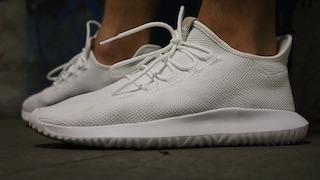 These Adidas knit shoes have a built in tongue.
These Adidas knit shoes have a built in tongue.Collar
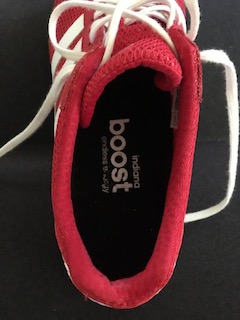 Athletic shoe collar
Athletic shoe collarJust like your head goes through the collar of your shirt, your feet go through the collars of your athletic shoes. The collar is the thicker, often padded part of the shoe surrounding your ankle and keeping your foot in place.
The collar sometimes extends further up on the back of your ankle and may include an Achilles notch (see below) and/or a loop or heel tab that you can use to help you pull the shoe on more easily.
The collar is usually higher on the inside of your ankle and lower on the outside. This is because it follows your ankle bone, which is lower on the outside of your foot. Since the shoe collar is supposed to fit comfortably under your ankle bones, it should always be asymmetrical.
Achilles Notch
This notch is an indentation in the athletic shoe collar that is designed to protect your Achilles tendon by lessening the pressure that your shoe puts on it. It can be u-shaped or v-shaped.
The Achilles tendon connects your calf muscles to your heel bone and runs down the back of your ankle. Its function is important to walking, running, and jumping because it allows you to get up on your toes.
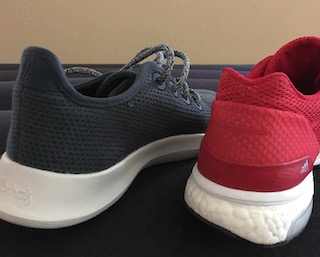 My Allbirds don't have an Achilles notch, but my Adidas do. Do you see the difference?
My Allbirds don't have an Achilles notch, but my Adidas do. Do you see the difference?Extra Eyelets
You probably know that the lacing loops that hold your shoe’s laces are called eyelets, and they can be plastic, metal, or just an opening in the fabric of the shoe. Athletic shoes with more eyelets allow a more custom fit because they offer more opportunities to adjust the tension. (For more in-depth information about shoelaces, check out this webpage.)
But did you know that most athletic shoes have an extra set of eyelets at the top of the shoe? They may sit at an angle compared to the rest of the eyelets. These extra eyelets aren’t just for show…they actually serve a purpose. If you have a narrow heel or if your shoes tend to slip off your heels, you can try creating a heel lock lacing system using these extra eyelets.
A heel lock is designed to make your shoe fit more snugly around the ankle and help keep the laces and tongue from slipping. It involves tying a loop through the extra eyelets, which forces your foot back toward the heel of your shoe, creating more shoe stability.
You can see how to do this in the video below:
Just don’t tie them too tightly so you don’t injure the tendons or joints, or irritate the nerves in your feet.
But it really is important that your shoes aren’t too loose. Having too much side-to-side motion in your feet can cause blisters or tendinitis. Too much movement from front to back can lead to pain or burning on the bottom of your forefoot, bruised toes, or bruised and broken toenails that take a long time to heal. Creating a heel lock with these extra eyelets can prevent these issues.
Foxing
This is a shoe part that I had never heard of until I started writing this article. But I thought it sounded interesting, so I wanted to include it.
According to the Footwear Distributors and Retailers of America (FDRA), a foxing is “a strip of material, separate from the sole and upper, that secures the joint where the upper and sole meet, usually attached by a vulcanization process. A foxing must be applied or molded at the sole and overlap the upper and substantially encircle the entire shoe.”
Basically, this material covers the line where the upper and the sole come together. It can help protect the glue that holds these pieces together to help it last longer.
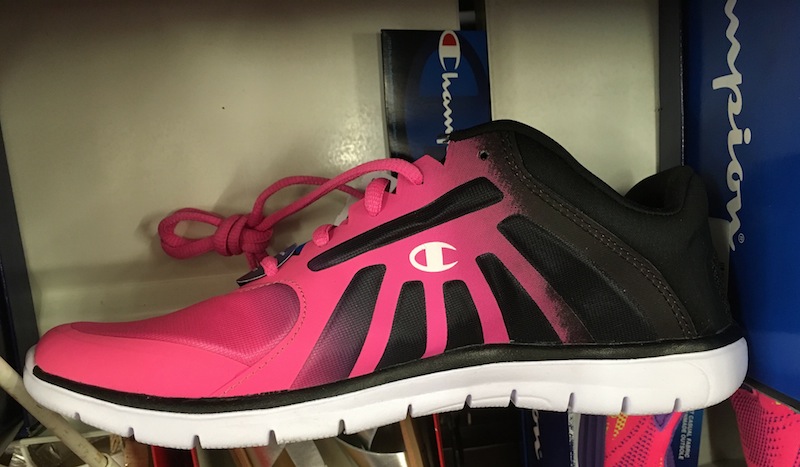 The shoe foxing is the strip where the upper and sole meet.
The shoe foxing is the strip where the upper and sole meet.So I guess it’s not as interesting as I thought!
But I do wonder where the term originated. Why is that part of a shoe called foxing? I couldn't find anything online about the origin. I reached out the FDRA and asked if anyone there knew, but I have not received a response from them yet.
The only thing I can think of is that it might be related to another meaning of the word. The verb foxing can mean to trick or deceive. So maybe the shoe industry began using the term because the material looks like it’s part of the shoe upper when it’s really not, so it’s deceiving. Just a thought.
If you have any other information about the origin of this word, please contact me through the form at the bottom of this page and let me know! I will share your answers here.
Heel Counter
The heel counter is the rigid, external covering around the outside of your athletic shoe’s heel. Why is this part important? It helps your shoe keep its shape and stability against the impact your foot faces when running. It also helps control your foot’s pronation and provides some support for your foot and ankle.
A heel counter that is made with hard plastic that doesn’t bend when you apply pressure to the back of the shoe will offer the best support. Some lightweight running or training shoes have heel counters that are thin and flexible, so they don’t offer much support. It’s important to know how much support you are looking for when choosing your athletic shoes.
The heel counter is a part that is especially important to runners. When you run, your foot generally lands first on the outside portion of your heel. If the heel counter isn’t supportive enough, the back of the shoe can break down, which can lead to loss of foot control or injury.
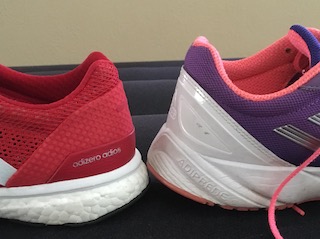 Some heel counters are the same color as the rest of the shoe, but others are a different color.
Some heel counters are the same color as the rest of the shoe, but others are a different color.Decoupled Heel
Have you ever wondered why some athletic shoes have heels with spaces in between some of the outsole materials? You can see what I mean in this picture:
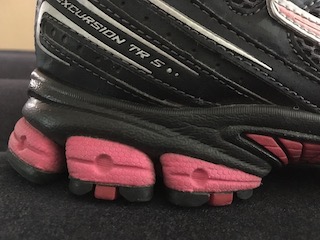 An example of a decoupled heel
An example of a decoupled heelThis is called a decoupled heel. The split in the material is designed to absorb shock, especially when your foot lands on a hard surface like concrete. The majority of runners land on their heels first when they stride, so the splits create a sort of independent suspension like the shock absorbers in your vehicle.
The spaces help reduce the force of impact as it travels from the heel to the rest of the foot.
Shoe Drop
No, shoe drop does not refer to the phenomenon of dropping your shoes in the house wherever you take them off and leaving them there so everyone else can trip on them!
This term actually describes the height difference between a shoe’s heel and forefoot, and it’s measured in millimeters. Drop may also be referred to as heel to toe drop, heel toe offset, heel toe differential, or heel toe lift.
An athletic shoe’s drop might be important to runners, especially, because it can affect how your foot strikes the ground.
A drop of 0 to 4 millimeters (zero drop to low drop) helps with a more natural strike at the midfoot. This type of shoe is best for neutral runners. (See the foot type section of this website for more information.) The recent trendy “minimal” shoes that mimic barefoot running are an example of zero drop shoes.
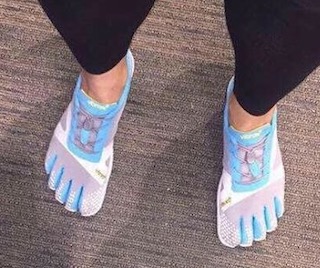 Minimal shoes have a shoe drop of zero.
Minimal shoes have a shoe drop of zero.A drop of 4 to 8 millimeters provides cushioning for runners with high arches and stability for people who overpronate.
A larger drop of 8 to 12 millimeters will make it more likely that you will strike the ground with your heel as you run. If you naturally land heel to toe, a shoe with a large drop may be right for you.
The flatter the shoe, or the lower its drop, the more your midfoot will strike the ground. This is considered the most natural stride and the one that sends the least amount of shock up your leg when running, potentially lessening your chance of injury. But if you don’t naturally strike the ground this way, you may not be comfortable with the lack of cushioning in the heel.
You will most likely see the term drop being discussed with running shoes since it involves the amount of cushioning and the way your foot strikes the ground when you are running. But it occasionally shows up with shoes for other sports.
In tennis, for instance, low or zero drop shoes are encouraged as a way to minimize ankle injuries. With all the lateral movements that happen on the court, the thought is that the lower your heel is to the ground, the less chance you have of rolling your ankle when you move quickly side to side.
Basketball and volleyball, conversely, involve more jumping and therefore usually call for more cushioning than zero drop shoes would provide.
Shoe Ride
Although shoe “ride” is not necessarily a physical part of the athletic shoe that you can see, if your shoe doesn’t have it, you’ll know.
Shoe ride a term that is probably well known to runners, but not as obvious to those of us who are less serious athletes. It describes how well a shoe transfers the wearer’s weight from the time your heel strikes the ground through the push off from your toe. If it’s not a smooth weight transfer, then you know the shoe doesn’t have a good ride.
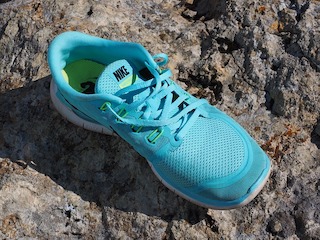 Shoe ride is important in running shoes.
Shoe ride is important in running shoes.Another way to define shoe ride is to describe how it feels to run in the shoe. If the shoe has a plush ride, it feels extra soft when you’re running. But if it feels like it bounces back and returns energy when it hits the ground, then it has a responsive ride.
The concept of shoe ride seems to be subjective to the person experiencing it rather than being something measured and consistent. One runner may feel a particular shoe has a smooth ride, while another runner might not consider that same shoe to have a smooth ride.
Also, experiments have shown that just because a shoe has a softer midsole does not necessarily mean it will have a smoother ride than a shoe with a stiff midsole.
The subjective differences in the concept of shoe ride from person to person are most likely due to differences in natural running motion, foot structure, muscle strength and coordination.
Shoe Last
And the last item on this list is…the last. I planned it that way, of course.
This one is not actually a part of your athletic shoe, but without it, your shoe would not exist.
A shoe last is the three-dimensional mold that is shaped like a foot and is used to construct a shoe. It’s usually made of wood, plastic, or iron and includes heel width, instep height, and forefoot width.
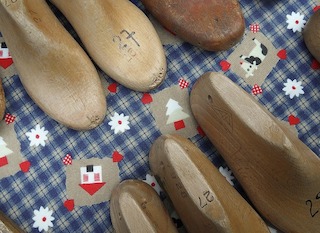 Examples of shoe lasts
Examples of shoe lastsThe shape of the shoe last used to make a particular shoe determines the shape of the shoe itself. Lasts can be straight, semi-curved, or curved. Athletic shoes that are built with straight lasts are straight from heel to toe, and they are usually designed as motion control shoes. This type of shoe is less flexible and is meant to help people who overpronate.
A semi-curved last has just a slight inward curve from heel to toe. Shoes made with this type of last tend to be neutral shoes for people with normal arches, or stability shoes for people who need a little more flexibility with their support.
A curved last has a more pronounced inward curve and is used for people with high arches. These lasts are used for shoes that are very lightweight or for racing.
Different construction techniques are used to attach athletic shoe uppers to midsoles, and these techniques are called shoe lasting. There are four types:
Slip Last – The shoe upper is stitched directly to the midsole with a seam running down the center of the footbed.
Board Last – A flexible board is attached to top of the midsole and then the upper is stitched or glued to the board.
Combination Last – This type of shoe construction uses the slip method in the forefoot and the board method for the heel.
Strobel Last – This method is most common for running shoes. Instead of a firm board, it uses a thin sheet of material glued to the midsole, and then the upper is stitched to that material.
Other Important Athletic Shoe Parts
So how many of these athletic shoe parts were you aware of before you read this article? Are there any others you think are important that I haven’t mentioned here? Feel free to contact me and let me know.
Hopefully you have found this information helpful. You may want to give some thought to these parts next time you’re shopping for athletic shoes. They may make a difference in which ones you choose to buy.
Note: As an Amazon Associate, I earn from qualifying purchases.
